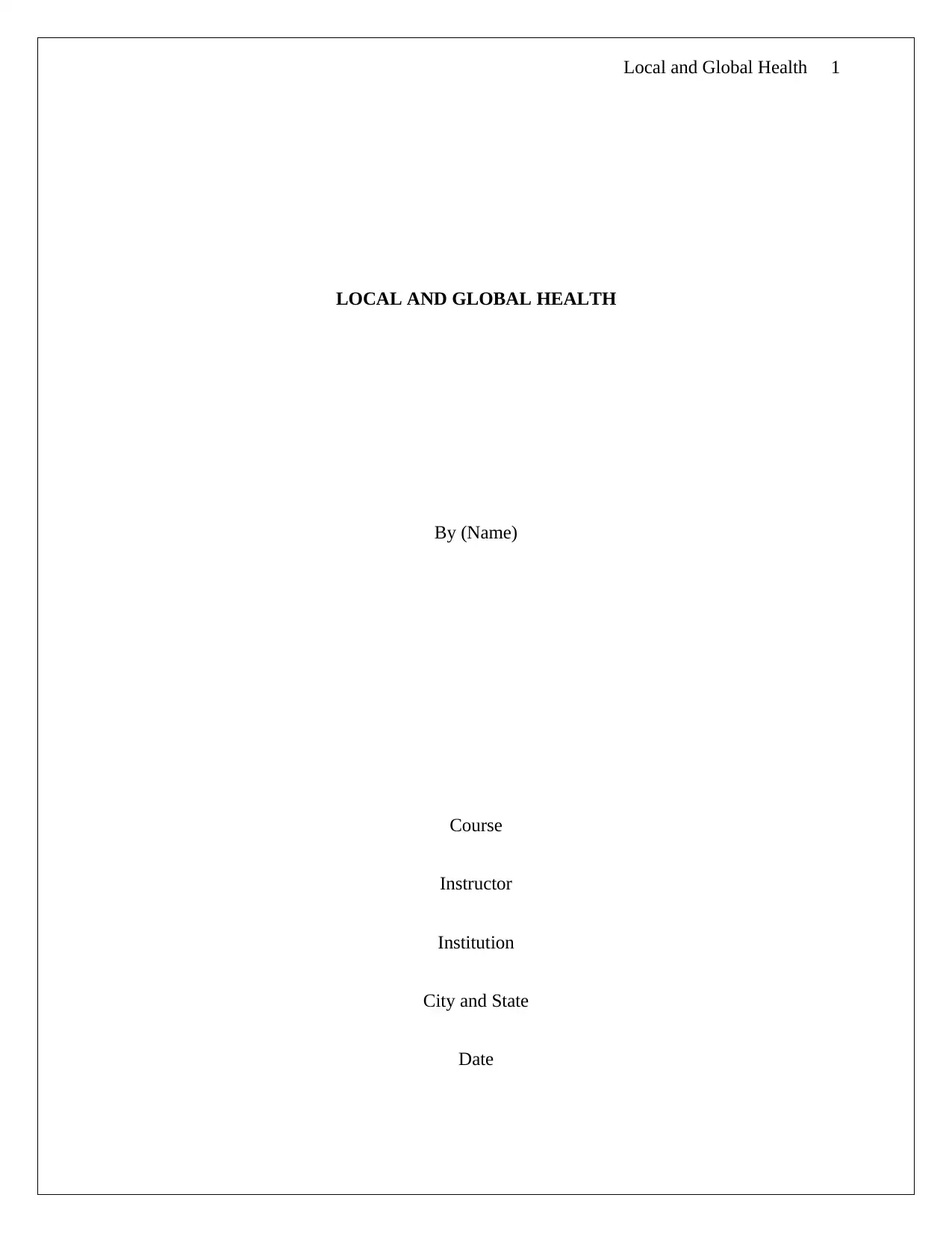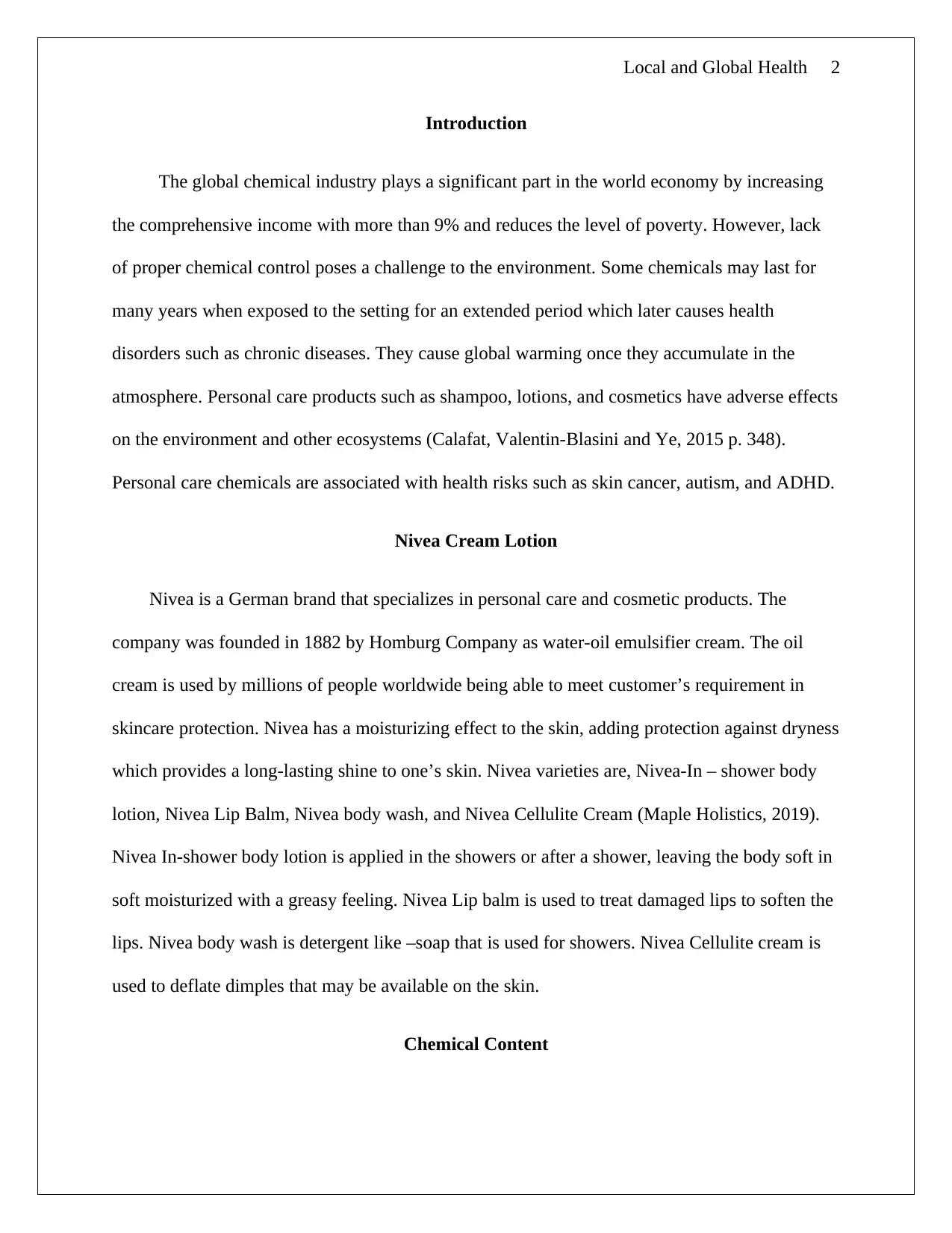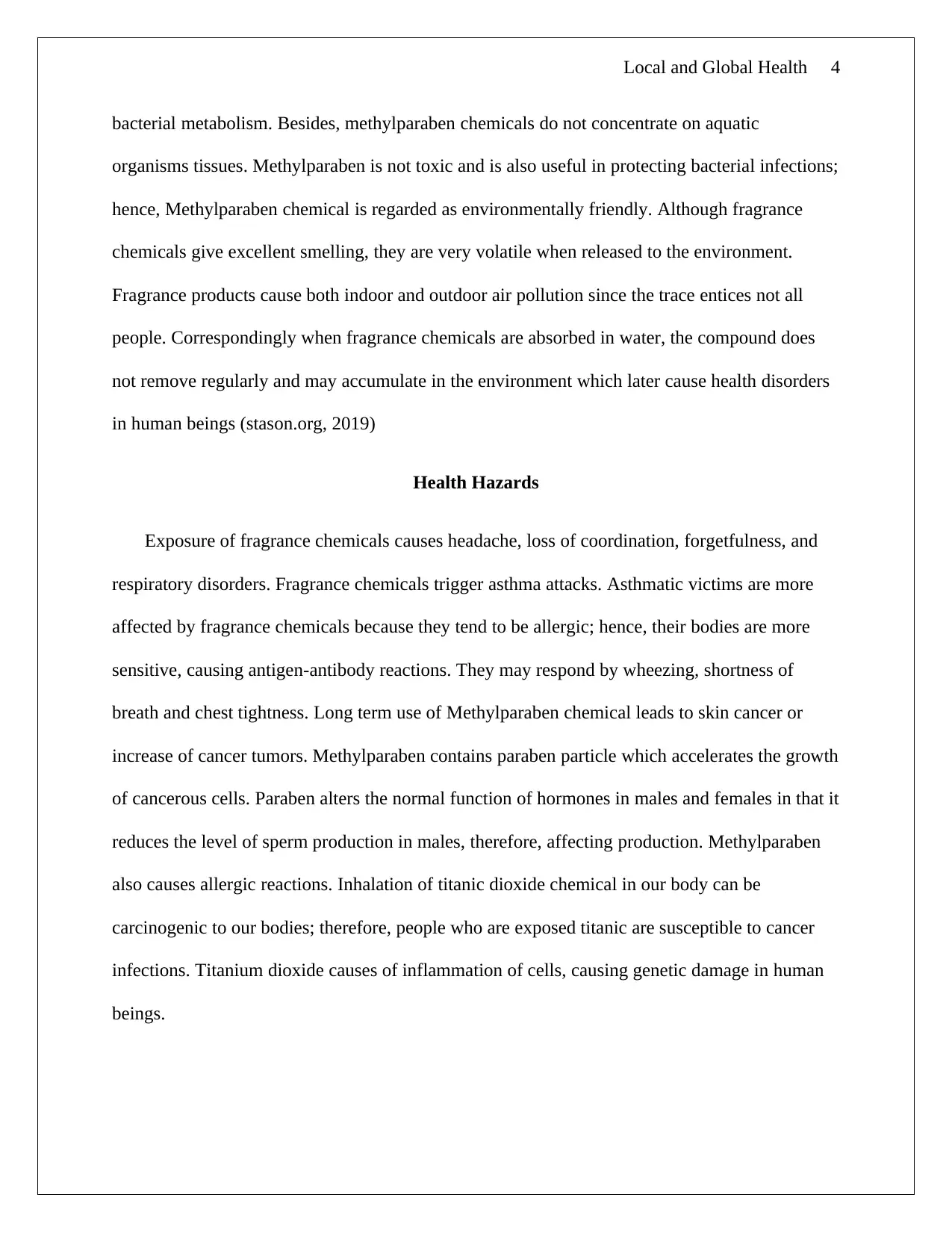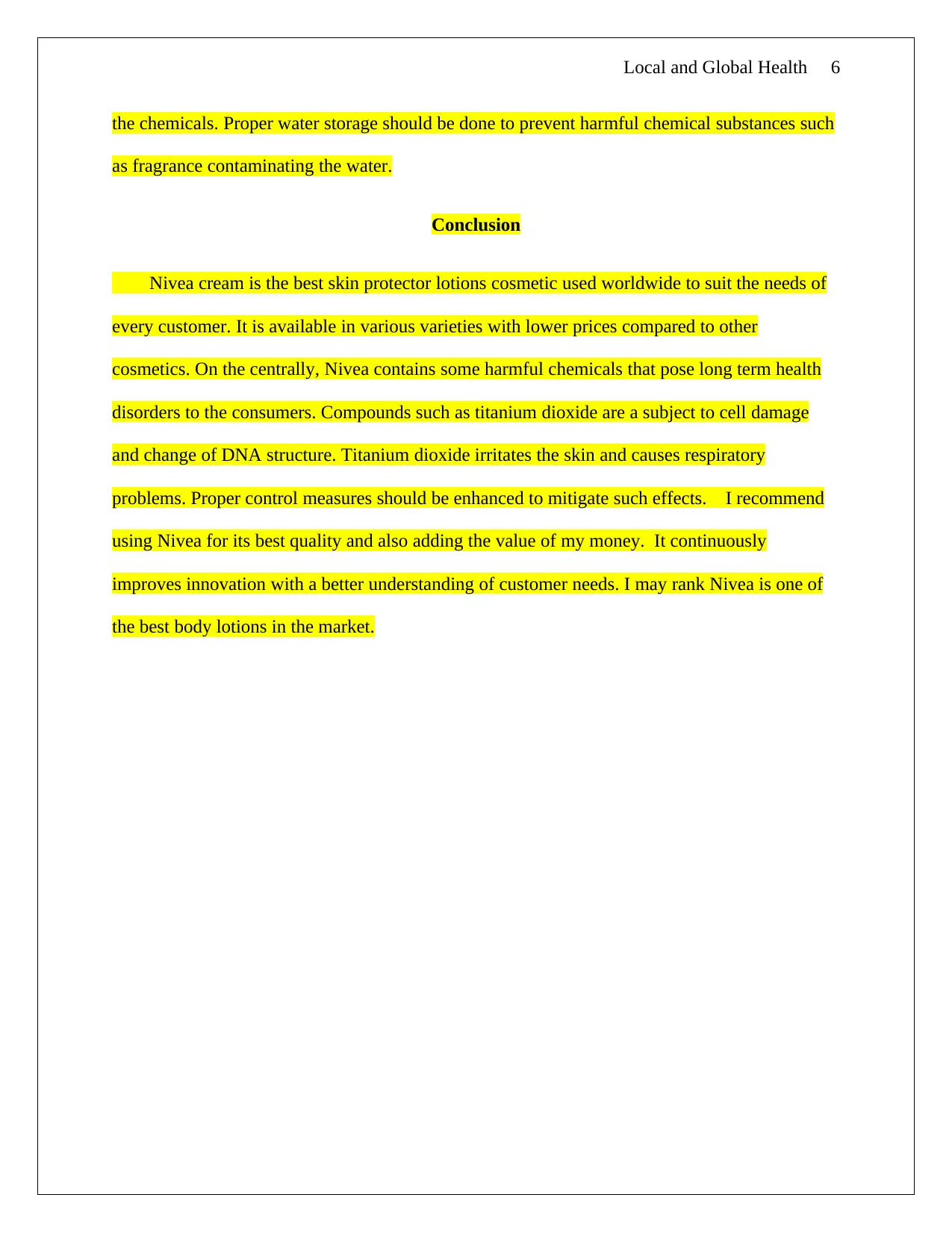HSH112 - Local and Global Health: Nivea Cream Environmental Analysis
VerifiedAdded on 2022/11/12
|8
|1703
|192
Report
AI Summary
This report examines Nivea cream, a popular personal care product, analyzing its chemical composition and potential impacts on both local and global health. The report details the ingredients of Nivea, including titanium dioxide, methylparaben, and fragrance chemicals, and discusses their effects on the environment and human health. It highlights the adverse effects of titanium dioxide on plant life and the potential carcinogenic and genotoxic effects on humans, while also acknowledging the biodegradability of methylparaben. The report also addresses the health hazards associated with fragrance chemicals, such as headaches and respiratory disorders, as well as the long-term effects of methylparaben. Furthermore, the report outlines chemical control measures, including proper labeling, consumer awareness, and regulatory oversight, and provides a comprehensive overview of the product's benefits and drawbacks, culminating in recommendations for minimizing exposure to harmful chemicals. The report references scientific studies to support its claims, providing a well-researched analysis of the product's impact.

Local and Global Health 1
LOCAL AND GLOBAL HEALTH
By (Name)
Course
Instructor
Institution
City and State
Date
LOCAL AND GLOBAL HEALTH
By (Name)
Course
Instructor
Institution
City and State
Date
Paraphrase This Document
Need a fresh take? Get an instant paraphrase of this document with our AI Paraphraser

Local and Global Health 2
Introduction
The global chemical industry plays a significant part in the world economy by increasing
the comprehensive income with more than 9% and reduces the level of poverty. However, lack
of proper chemical control poses a challenge to the environment. Some chemicals may last for
many years when exposed to the setting for an extended period which later causes health
disorders such as chronic diseases. They cause global warming once they accumulate in the
atmosphere. Personal care products such as shampoo, lotions, and cosmetics have adverse effects
on the environment and other ecosystems (Calafat, Valentin-Blasini and Ye, 2015 p. 348).
Personal care chemicals are associated with health risks such as skin cancer, autism, and ADHD.
Nivea Cream Lotion
Nivea is a German brand that specializes in personal care and cosmetic products. The
company was founded in 1882 by Homburg Company as water-oil emulsifier cream. The oil
cream is used by millions of people worldwide being able to meet customer’s requirement in
skincare protection. Nivea has a moisturizing effect to the skin, adding protection against dryness
which provides a long-lasting shine to one’s skin. Nivea varieties are, Nivea-In – shower body
lotion, Nivea Lip Balm, Nivea body wash, and Nivea Cellulite Cream (Maple Holistics, 2019).
Nivea In-shower body lotion is applied in the showers or after a shower, leaving the body soft in
soft moisturized with a greasy feeling. Nivea Lip balm is used to treat damaged lips to soften the
lips. Nivea body wash is detergent like –soap that is used for showers. Nivea Cellulite cream is
used to deflate dimples that may be available on the skin.
Chemical Content
Introduction
The global chemical industry plays a significant part in the world economy by increasing
the comprehensive income with more than 9% and reduces the level of poverty. However, lack
of proper chemical control poses a challenge to the environment. Some chemicals may last for
many years when exposed to the setting for an extended period which later causes health
disorders such as chronic diseases. They cause global warming once they accumulate in the
atmosphere. Personal care products such as shampoo, lotions, and cosmetics have adverse effects
on the environment and other ecosystems (Calafat, Valentin-Blasini and Ye, 2015 p. 348).
Personal care chemicals are associated with health risks such as skin cancer, autism, and ADHD.
Nivea Cream Lotion
Nivea is a German brand that specializes in personal care and cosmetic products. The
company was founded in 1882 by Homburg Company as water-oil emulsifier cream. The oil
cream is used by millions of people worldwide being able to meet customer’s requirement in
skincare protection. Nivea has a moisturizing effect to the skin, adding protection against dryness
which provides a long-lasting shine to one’s skin. Nivea varieties are, Nivea-In – shower body
lotion, Nivea Lip Balm, Nivea body wash, and Nivea Cellulite Cream (Maple Holistics, 2019).
Nivea In-shower body lotion is applied in the showers or after a shower, leaving the body soft in
soft moisturized with a greasy feeling. Nivea Lip balm is used to treat damaged lips to soften the
lips. Nivea body wash is detergent like –soap that is used for showers. Nivea Cellulite cream is
used to deflate dimples that may be available on the skin.
Chemical Content

Local and Global Health 3
Nivea is made up of various chemical ingredients that hasten its efficiency. Nivea consists of
Anti-Wrinkle moisturizer with Nano titanium dioxide particles of 100nm, which is added to the
cosmetic to prevent wrinkles to the skin. It also protects the skin against ultraviolet light (UV
light). It has elementary properties that allow it to be thicker and brighter, hence used for sun
screening in cosmetic industries (Pulvin, 2015 p. 3). Methylparaben is an ingredient of Nivea
cosmetics, used as a preservative to prevent microbial alteration, consequently protecting the
final consumer against fungal infections.
Additionally, Methylparaben has efficiency absorption to the skin, therefore regarded as non-
irritating compound (Mincea et al., 2009 p. 669). Methylparaben is non-toxic; hence, it used to
preserve food. Fragrance chemical, also known as perfume, is added in Nivea products to give
good redolence. The wonderful smell contributes to consumer's self-esteem and individuality.
Environmental Effects
Nivea may cause adverse effects to one's health and environment at large. The titanium
dioxide chemical used to make Nivea has adverse effects when absorbed by the plants. Nano
titanium particles affect soil microbes which are associated with the rhizosphere that supports root
development (Burke et al., 2015 p. 23630) When titanium is absorbed directly by plants; they
have a negative effect in that it inhabits root plant germination, photosynthetic usage and
inducing general toxicity to plants. Titanium dioxide produces reactive oxygen species when
exposed to the environment damages cell structures and DNA (Cox et al., 2016 p. 147). The
reason because the titanium dioxide is highly carcinogenic and genotoxic.
Methylparaben chemical used in cosmetics causes less environmental hazards. The
methylparaben is 100% biodegradable and can be removed from the environment through
Nivea is made up of various chemical ingredients that hasten its efficiency. Nivea consists of
Anti-Wrinkle moisturizer with Nano titanium dioxide particles of 100nm, which is added to the
cosmetic to prevent wrinkles to the skin. It also protects the skin against ultraviolet light (UV
light). It has elementary properties that allow it to be thicker and brighter, hence used for sun
screening in cosmetic industries (Pulvin, 2015 p. 3). Methylparaben is an ingredient of Nivea
cosmetics, used as a preservative to prevent microbial alteration, consequently protecting the
final consumer against fungal infections.
Additionally, Methylparaben has efficiency absorption to the skin, therefore regarded as non-
irritating compound (Mincea et al., 2009 p. 669). Methylparaben is non-toxic; hence, it used to
preserve food. Fragrance chemical, also known as perfume, is added in Nivea products to give
good redolence. The wonderful smell contributes to consumer's self-esteem and individuality.
Environmental Effects
Nivea may cause adverse effects to one's health and environment at large. The titanium
dioxide chemical used to make Nivea has adverse effects when absorbed by the plants. Nano
titanium particles affect soil microbes which are associated with the rhizosphere that supports root
development (Burke et al., 2015 p. 23630) When titanium is absorbed directly by plants; they
have a negative effect in that it inhabits root plant germination, photosynthetic usage and
inducing general toxicity to plants. Titanium dioxide produces reactive oxygen species when
exposed to the environment damages cell structures and DNA (Cox et al., 2016 p. 147). The
reason because the titanium dioxide is highly carcinogenic and genotoxic.
Methylparaben chemical used in cosmetics causes less environmental hazards. The
methylparaben is 100% biodegradable and can be removed from the environment through
⊘ This is a preview!⊘
Do you want full access?
Subscribe today to unlock all pages.

Trusted by 1+ million students worldwide

Local and Global Health 4
bacterial metabolism. Besides, methylparaben chemicals do not concentrate on aquatic
organisms tissues. Methylparaben is not toxic and is also useful in protecting bacterial infections;
hence, Methylparaben chemical is regarded as environmentally friendly. Although fragrance
chemicals give excellent smelling, they are very volatile when released to the environment.
Fragrance products cause both indoor and outdoor air pollution since the trace entices not all
people. Correspondingly when fragrance chemicals are absorbed in water, the compound does
not remove regularly and may accumulate in the environment which later cause health disorders
in human beings (stason.org, 2019)
Health Hazards
Exposure of fragrance chemicals causes headache, loss of coordination, forgetfulness, and
respiratory disorders. Fragrance chemicals trigger asthma attacks. Asthmatic victims are more
affected by fragrance chemicals because they tend to be allergic; hence, their bodies are more
sensitive, causing antigen-antibody reactions. They may respond by wheezing, shortness of
breath and chest tightness. Long term use of Methylparaben chemical leads to skin cancer or
increase of cancer tumors. Methylparaben contains paraben particle which accelerates the growth
of cancerous cells. Paraben alters the normal function of hormones in males and females in that it
reduces the level of sperm production in males, therefore, affecting production. Methylparaben
also causes allergic reactions. Inhalation of titanic dioxide chemical in our body can be
carcinogenic to our bodies; therefore, people who are exposed titanic are susceptible to cancer
infections. Titanium dioxide causes of inflammation of cells, causing genetic damage in human
beings.
bacterial metabolism. Besides, methylparaben chemicals do not concentrate on aquatic
organisms tissues. Methylparaben is not toxic and is also useful in protecting bacterial infections;
hence, Methylparaben chemical is regarded as environmentally friendly. Although fragrance
chemicals give excellent smelling, they are very volatile when released to the environment.
Fragrance products cause both indoor and outdoor air pollution since the trace entices not all
people. Correspondingly when fragrance chemicals are absorbed in water, the compound does
not remove regularly and may accumulate in the environment which later cause health disorders
in human beings (stason.org, 2019)
Health Hazards
Exposure of fragrance chemicals causes headache, loss of coordination, forgetfulness, and
respiratory disorders. Fragrance chemicals trigger asthma attacks. Asthmatic victims are more
affected by fragrance chemicals because they tend to be allergic; hence, their bodies are more
sensitive, causing antigen-antibody reactions. They may respond by wheezing, shortness of
breath and chest tightness. Long term use of Methylparaben chemical leads to skin cancer or
increase of cancer tumors. Methylparaben contains paraben particle which accelerates the growth
of cancerous cells. Paraben alters the normal function of hormones in males and females in that it
reduces the level of sperm production in males, therefore, affecting production. Methylparaben
also causes allergic reactions. Inhalation of titanic dioxide chemical in our body can be
carcinogenic to our bodies; therefore, people who are exposed titanic are susceptible to cancer
infections. Titanium dioxide causes of inflammation of cells, causing genetic damage in human
beings.
Paraphrase This Document
Need a fresh take? Get an instant paraphrase of this document with our AI Paraphraser

Local and Global Health 5
Chemical Control
The European Commission requested Scientific Committee on Cosmetic and Non Food
Products Intended for Consumers (SCCNFP) to perform safety evaluation on all cosmetic
chemicals by examining and testing of various cosmetic ingredients in order reassess both
environmental and health hazards involved. The committee advised that there should be proper
labeling, directive instructions for use, and appropriate methods of disposal of any cosmetic
product. Consumers should be informed about the chemical composition of the cosmetic product
and health effects associated with the chemical ingredients. Warnings and restrictions should
also be well written on the label. This is evident in Swedish Chemical Agency been working
with cosmetic companies and toy industries by ensuring it creates awareness of the chemical
components in various cosmetic and toy products (Molander and Cohen, 2012 p 521) done
through training.
There should be strategies to monitor all the misleading advertisements of cosmetic products
by all manufacturing companies. Manufacturing companies mislead consumers by giving false
information about the product in the media. Some of the manufacturing company use dangerous
artificial chemicals, but they indicate the ingredients are natural. Harsh penalties should be
charged against the misleading manufacturing companies to reduce exposure of the harmful
chemicals to the environment.
There should be legislative regulation of various toxic chemicals used in cosmetic products to
reduce the exposure of such compounds. Different poisonous substances such as titanium
dioxide should be burned in cosmetic industries for their health effects. Enforcement can also be
done by inspecting cosmetic manufacturing industries to dwindle health effects associated with
Chemical Control
The European Commission requested Scientific Committee on Cosmetic and Non Food
Products Intended for Consumers (SCCNFP) to perform safety evaluation on all cosmetic
chemicals by examining and testing of various cosmetic ingredients in order reassess both
environmental and health hazards involved. The committee advised that there should be proper
labeling, directive instructions for use, and appropriate methods of disposal of any cosmetic
product. Consumers should be informed about the chemical composition of the cosmetic product
and health effects associated with the chemical ingredients. Warnings and restrictions should
also be well written on the label. This is evident in Swedish Chemical Agency been working
with cosmetic companies and toy industries by ensuring it creates awareness of the chemical
components in various cosmetic and toy products (Molander and Cohen, 2012 p 521) done
through training.
There should be strategies to monitor all the misleading advertisements of cosmetic products
by all manufacturing companies. Manufacturing companies mislead consumers by giving false
information about the product in the media. Some of the manufacturing company use dangerous
artificial chemicals, but they indicate the ingredients are natural. Harsh penalties should be
charged against the misleading manufacturing companies to reduce exposure of the harmful
chemicals to the environment.
There should be legislative regulation of various toxic chemicals used in cosmetic products to
reduce the exposure of such compounds. Different poisonous substances such as titanium
dioxide should be burned in cosmetic industries for their health effects. Enforcement can also be
done by inspecting cosmetic manufacturing industries to dwindle health effects associated with

Local and Global Health 6
the chemicals. Proper water storage should be done to prevent harmful chemical substances such
as fragrance contaminating the water.
Conclusion
Nivea cream is the best skin protector lotions cosmetic used worldwide to suit the needs of
every customer. It is available in various varieties with lower prices compared to other
cosmetics. On the centrally, Nivea contains some harmful chemicals that pose long term health
disorders to the consumers. Compounds such as titanium dioxide are a subject to cell damage
and change of DNA structure. Titanium dioxide irritates the skin and causes respiratory
problems. Proper control measures should be enhanced to mitigate such effects. I recommend
using Nivea for its best quality and also adding the value of my money. It continuously
improves innovation with a better understanding of customer needs. I may rank Nivea is one of
the best body lotions in the market.
the chemicals. Proper water storage should be done to prevent harmful chemical substances such
as fragrance contaminating the water.
Conclusion
Nivea cream is the best skin protector lotions cosmetic used worldwide to suit the needs of
every customer. It is available in various varieties with lower prices compared to other
cosmetics. On the centrally, Nivea contains some harmful chemicals that pose long term health
disorders to the consumers. Compounds such as titanium dioxide are a subject to cell damage
and change of DNA structure. Titanium dioxide irritates the skin and causes respiratory
problems. Proper control measures should be enhanced to mitigate such effects. I recommend
using Nivea for its best quality and also adding the value of my money. It continuously
improves innovation with a better understanding of customer needs. I may rank Nivea is one of
the best body lotions in the market.
⊘ This is a preview!⊘
Do you want full access?
Subscribe today to unlock all pages.

Trusted by 1+ million students worldwide

Local and Global Health 7
Bibliography
Burke, D., Pietrasiak, N., Situ, S., Abenojar, E., Porche, M., Kraj, P., Lakliang, Y. and Samia, A.
(2015). Iron Oxide and Titanium Dioxide Nanoparticle Effects on Plant Performance and Root
Associated Microbes. International Journal of Molecular Sciences, 16(10), pp.23630-23650.
Calafat, A., Valentin-Blasini, L. and Ye, X. (2015). Trends in Exposure to Chemicals in Personal
Care and Consumer Products. Current Environmental Health Reports, 2(4), pp.348-355.
Cox, A., Venkatachalam, P., Sahi, S., and Sharma, N. (2016). Silver and titanium dioxide
nanoparticle toxicity in plants: A review of current research. Plant Physiology and Biochemistry,
107, pp.147-163.
Maple Holistic. (2019). Top 10 Nivea Skincare Products Breakdown 2019: Know Your Nivea.
[online] Available at: https://www.mapleholistics.com/blog/know-your-nivea-top-10-nivea-
skincare-products/ [Accessed 15 Sep. 2019
Mincea, M., Lupşa, I., Cinghiţă, D., Radovan, C., and Talpos, I. (2009). Determination of
methylparaben from cosmetic products by ultra-performance liquid chromatography. Journal of
the Serbian Chemical Society, 74(6), pp.669-676.
Molander, L., and Cohen, A. (2012). EU and US Regulatory Approach to Information on
Chemicals in Products: Implications for Consumers. European Journal of Risk Regulation, 3(4),
pp.521-533.
Pulvin, S. (2015). Toxicity Associated with the Photo Catalytic and Photo Stable Forms of
Titanium Dioxide Nanoparticles Used in Sunscreen lotion. MOJ Toxicology, 1(3).
Bibliography
Burke, D., Pietrasiak, N., Situ, S., Abenojar, E., Porche, M., Kraj, P., Lakliang, Y. and Samia, A.
(2015). Iron Oxide and Titanium Dioxide Nanoparticle Effects on Plant Performance and Root
Associated Microbes. International Journal of Molecular Sciences, 16(10), pp.23630-23650.
Calafat, A., Valentin-Blasini, L. and Ye, X. (2015). Trends in Exposure to Chemicals in Personal
Care and Consumer Products. Current Environmental Health Reports, 2(4), pp.348-355.
Cox, A., Venkatachalam, P., Sahi, S., and Sharma, N. (2016). Silver and titanium dioxide
nanoparticle toxicity in plants: A review of current research. Plant Physiology and Biochemistry,
107, pp.147-163.
Maple Holistic. (2019). Top 10 Nivea Skincare Products Breakdown 2019: Know Your Nivea.
[online] Available at: https://www.mapleholistics.com/blog/know-your-nivea-top-10-nivea-
skincare-products/ [Accessed 15 Sep. 2019
Mincea, M., Lupşa, I., Cinghiţă, D., Radovan, C., and Talpos, I. (2009). Determination of
methylparaben from cosmetic products by ultra-performance liquid chromatography. Journal of
the Serbian Chemical Society, 74(6), pp.669-676.
Molander, L., and Cohen, A. (2012). EU and US Regulatory Approach to Information on
Chemicals in Products: Implications for Consumers. European Journal of Risk Regulation, 3(4),
pp.521-533.
Pulvin, S. (2015). Toxicity Associated with the Photo Catalytic and Photo Stable Forms of
Titanium Dioxide Nanoparticles Used in Sunscreen lotion. MOJ Toxicology, 1(3).
Paraphrase This Document
Need a fresh take? Get an instant paraphrase of this document with our AI Paraphraser

Local and Global Health 8
stason.org, S. (2019). Fragrance: A Growing Health and Environmental Hazard. Part 1.
[Online] Stason.org. Available at:
https://stason.org/articles/wellbeing/health/environment/Fragrance-A-Growing-Health-and-
Environmental-Hazard-Part-1.html [Accessed 16 Sep. 2019].
stason.org, S. (2019). Fragrance: A Growing Health and Environmental Hazard. Part 1.
[Online] Stason.org. Available at:
https://stason.org/articles/wellbeing/health/environment/Fragrance-A-Growing-Health-and-
Environmental-Hazard-Part-1.html [Accessed 16 Sep. 2019].
1 out of 8
Your All-in-One AI-Powered Toolkit for Academic Success.
+13062052269
info@desklib.com
Available 24*7 on WhatsApp / Email
![[object Object]](/_next/static/media/star-bottom.7253800d.svg)
Unlock your academic potential
Copyright © 2020–2025 A2Z Services. All Rights Reserved. Developed and managed by ZUCOL.